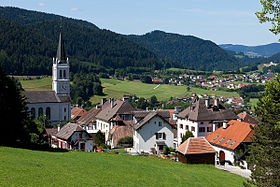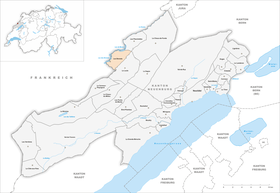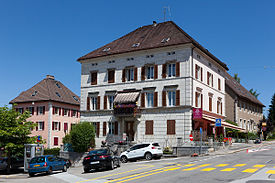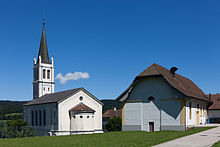Les Brenets
| Les Brenets | |
|---|---|
| State : |
|
| Canton : |
|
| District : | No district division |
| BFS no. : | 6431 |
| Postal code : | 2416 |
| Coordinates : | 544319 / 213.42 thousand |
| Height : | 849 m above sea level M. |
| Height range : | 710–1253 m above sea level M. |
| Area : | 11.53 km² |
| Residents: | 1044 (December 31, 2018) |
| Population density : | 91 inhabitants per km² |
| Website: | www.lesbrenets.ch |
|
Les Brenets |
|
| Location of the municipality | |
Les Brenets is a municipality in the canton of Neuchâtel in Switzerland .
geography
Les Brenets is 849 m above sea level. M. , 10 km west-southwest of the city of La Chaux-de-Fonds (beeline). The village extends on a westward sloping slope in the Neuchâtel Jura , around 100 m above the Lac des Brenets formed by the Doubs .
The area of the 11.5 km² municipal area comprises the western part of the Pouillerel ridge in the High Jura. This ridge, divided by several small valleys, gradually descends to the west into the Doubs valley, while to the north it drops very steeply with distinctive rock faces ( Creux de Moron ) to the canyon-like cut Doubs. The north-western and northern border is formed by the Doubs, first in the Lac des Brenets, then with the Saut du Doubs waterfall and finally in the dammed Lac de Moron . The southwestern border follows the course of the Rançonnière , which drains the high valley of Le Locle and forms a swamp area at the confluence with the Lac des Brenets. In the south, the border is partly in the Combe de Monterban valley . The highest point of Les Brenets is 1257 m above sea level. M. reached on the ridge of the Pouillerel. Here there are extensive Jura high pastures with the typical mighty spruce trees , which either stand individually or in groups. In 1997, 5% of the municipal area was in settlements, 49% in forests and woodlands, 42% in agriculture and around 4% was unproductive land.
Les Brenets includes the districts of Bourg-Dessous , 788 m above sea level. M. below the village, Le Châtelard ( 914 m above sea level ) above the town center, as well as numerous individual farms scattered across the Jura heights. The neighboring communities of Les Brenets are Le Locle and Les Planchettes in the canton of Neuchâtel and Villers-le-Lac in neighboring France .
population
With 1044 inhabitants (as of December 31, 2018), Les Brenets is one of the medium-sized municipalities in the canton of Neuchâtel. 95.0% of the residents are French-speaking, 2.0% German-speaking and 1.6% Italian-speaking (as of 2000). The population of Les Brenets increased from 1750 (846 inhabitants) to 1860 (1547 inhabitants), and since then a continuous decrease has been recorded.
politics
The voting shares of the parties in the 2015 National Council election were: SVP 26.2%, PdA 26.1%, FDP 18.1%, SP 14.3%, GPS 7.1%, Nouveau Parti Libéral 2.9%, CVP 2 , 1%, glp 1.5%, list du vote blanc 1.5%, BDP 0.3%.
economy
Les Brenets was an agricultural village until the beginning of the 19th century . At the end of the 18th century , industrialization began with the introduction of watchmaking , lace making and stocking manufacture, which was initially carried out at home and from around 1830 in workshops and studios. Watchmaking and some electronics and precision engineering companies are still very important today . Agriculture, mainly cattle breeding , dairy farming and forestry , also employs a large number of people.
traffic
The community can be reached from Switzerland via the Col des Roches . The continuation of the road leads across the border to Villers-le-Lac. Les Brenets used to be on the relatively important connecting road from La Chaux-de-Fonds and Le Locle to Morteau in the French Jura, which brought the population additional income. It was only with the opening of the tunnel at the Col des Roches pass in 1847 that a direct connection from Le Locle to Villers-le-Lac was created.
On September 1, 1890, the Chemin de fer Régional des Brenets (RdB) inaugurated the meter-gauge railway line to Le Locle. The isolated railway line has been operated by Transports Publics Neuchâtelois (TransN) since 1999 .
An association was founded on September 10, 2013 . His goal is to develop this narrow-gauge railway.
tourism
Les Brenets is a popular destination thanks to its beautiful location, the Lac des Brenets , where water sports can be practiced, and the 27 m high Saut du Doubs waterfall on the Doubs below the lake . Between the lake and the waterfall there is a very beautiful gorge with rock walls to the right and left: Les Bassins du Doubs (basin), with calm water. In spring, summer and autumn you can take a boat through this gorge. In winter you can skate there. This sport in a wonderful environment was chosen as an intangible tradition in 2012 .
The village has overnight accommodation and a campsite.
history
The first written mention of the place dates back to 1325 under the name chiez le Bruignet , which can be traced back to the surname Brunet or Brenet . Most of the settlement came from France. Initially, Les Brenets was part of the Morteau Priory. In the 15th century, the lords of Valangin laid claim to the village. They initiated the construction of a parish church, which in 1520 moved from the diocese of Besançon to the diocese of Lausanne . With the introduction of the Reformation in 1534, Les Brenets finally came under the rule of Valangin, which has been under the county of Neuchâtel since 1592. From 1648 Neuchâtel was a principality and from 1707 it was linked to the Kingdom of Prussia through personal union. In 1806 the area was ceded to Napoleon I and came to the Swiss Confederation in the course of the Congress of Vienna in 1815 , whereby the kings of Prussia until the Neuchâtel trade in 1857 also remained princes of Neuchâtel. Since Les Brenets always had close ties to Le Locle and La Chaux-de-Fonds, it went through a similar industrial development as these two cities. In 1848, numerous houses were destroyed by a village fire. The town center was rebuilt in a checkerboard pattern.
Attractions
The current church of Les Brenets was built by the Swiss architect Louis-Daniel Perrier and consecrated in 1859. In the former church, built in 1511, the municipal administration is housed today. From the Tour Jürgensen , a building erected in 1874 in neo-Gothic style, there is a beautiful view of the village and the Doubstal with the Lac des Brenets .
House of the optician Pierre-Louis Guinand
Lac des Brenets formed by the Doubs
Saut du Doubs (27 m high waterfall)
Tour of the Juergensen observation tower
Railcar of the narrow-gauge railway Le Locle – Les Brenets
Personalities
- Pierre-Louis Guinand (1748–1824), optician
- Monique Laederach (1938–2004) writer
Web links
- Official website of the municipality of Les Brenets (French)
- Christine Müller: Les Brenets. In: Historical Lexicon of Switzerland .
- Tourist information for the Les Brenets / Doubs region
- Website of the shipping company Les Brenets-Saut-du-Doubs
Individual evidence
- ↑ Permanent and non-permanent resident population by year, canton, district, municipality, population type and gender (permanent resident population). In: bfs. admin.ch . Federal Statistical Office (FSO), August 31, 2019, accessed on December 22, 2019 .
- ^ Election du Conseil National du October 18, 2015, Résultats des partis - Les suffrages. (aspx) (No longer available online.) Chancellerie d'État neuchâtelois, October 18, 2015, archived from the original on November 1, 2015 ; Retrieved October 30, 2016 (French). Info: The archive link was inserted automatically and has not yet been checked. Please check the original and archive link according to the instructions and then remove this notice.
- ↑ Ice skating on the Doubs - living traditions. In: LebigetradUNGEN.ch. Retrieved December 23, 2014 .












